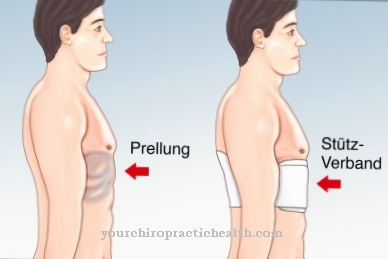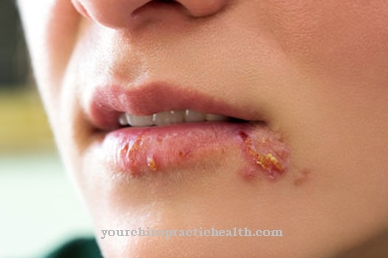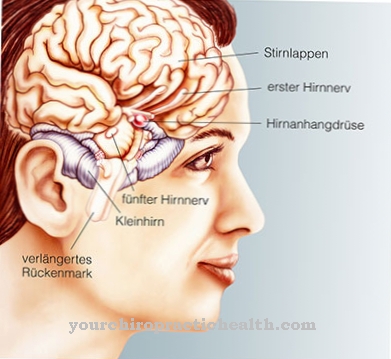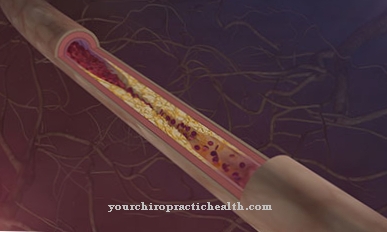The Loge de Guyon syndrome is an extremely rare disease that predominantly affects the ulnar nerve. Due to a constriction, there is a reduction in feeling in the area of the little and ring fingers. In addition to surgical treatment, conservative therapy is also possible; the prognosis for the disease is good.
What is Loge de Guyon Syndrome?

© Aksana - stock.adobe.com
The Loge de Guyon syndrome is a very rare disease that falls into the compression syndrome category. It is a compression of the ulnar nerve - the ulnar nerve. The so-called Loge de Guyon is located next to the carpal tunnel; in this is the motor branch of the ulnar nerve.
This branch not only connects the muscles of the metacarpal, but also the little or ring finger. If a narrowing occurs, which is primarily caused by ganglia - i.e. cysts on the wrist - then the typical symptoms of Loge de Guyon syndrome occur.
causes
The reason why the Loge de Guyon syndrome can develop at all is a constriction that directly affects the nerve in the so-called Guyon canal. This narrowing is triggered by a ganglion (cyst or overbone). The ganglion is (from a medical point of view) a benign tumor.
Sometimes, however, longer-term or often repeated compressions or overstretching of the nerve can also be the reason why the Loge de Guyon syndrome develops. Those factors are favored by motorcycling, cycling or the use of tools. "Crutch paralysis" can also trigger the Loge de Guyon syndrome. Other causes include fractures that have damaged or narrowed the structures of the Guyon Canal.
Symptoms, ailments & signs
The first symptoms of Loge de Guyon syndrome are abnormal sensations in the hand. Those affected usually feel a slight tingling sensation or numbness in the little finger and ring finger. The symptoms occur in connection with excessive strain on the wrist, such as is possible, for example, when cycling for a long time or doing push-ups.
However, there may be other triggers and symptoms will vary accordingly. In the course of the disease, chronic pain and weaknesses in the hand muscles can also occur. The affected hand can then no longer be moved as before, which results in restrictions in everyday life and, in the long term, subsequent hand problems.
A permanent relieving posture can lead to joint wear, muscle pain and cramps. Circulatory disorders are also conceivable. If the compression of the nerve persists over a long period of time, the muscles can atrophy and, as a result, deformities in the tissue of the little finger.
Pronounced forms are manifested by temporary symptoms of paralysis in the entire hand and especially in the fingers. The symptoms of Loge de Guyon syndrome usually appear insidious and are often only noticed when they are already very pronounced. Ultimately, the affected hand becomes stiff or unable to function.
Diagnosis & course of disease
As part of the diagnosis, the physician conducts an anamnesis and a clinical examination of the patient. If there is suspicion of damage to the nerve, an electrophysiological examination is usually carried out. During this examination, the nerve conduction velocity of the patient is measured. This test ensures the confirmation as well as the certainty whether the patient actually has the Loge de Guyon syndrome.
Magnetic resonance imaging, on the other hand, provides insight into whether and, if so, which structural causes have occurred that triggered the Loge de Guyon syndrome (e.g. whether a cyst or ganglion is present). Magnetic resonance tomography is only ordered in very few cases and is therefore not part of the classic examination method to determine the Loge de Guyon syndrome.
In the further course, the doctor decides whether conservative or surgical treatment is necessary. However, the patient must be patient when undergoing treatment. Only after a few weeks do the first signs of improvement appear; the final healing can sometimes take several months. However, if the disease is severe or if the ulnar nerve is so badly damaged, even surgical treatment cannot bring the desired success. This leaves a feeling of diminution, which mainly affects the hand muscles.
Complications
As a rule, the Loge de Guyon syndrome leads to various paralysis or sensory disorders, which mainly occur in the little finger and the ring finger. Furthermore, there are no complaints, whereby the paralysis and the disturbances of the sensitivity can also spread to the hand and the back of the hand. In most cases, there are no further complaints or complications.
Due to the Loge de Guyon syndrome, the everyday life of those affected is restricted and there are complaints and difficulties in different activities or in different professions. The quality of life is also reduced by the Loge de Guyon syndrome. If the symptoms appear suddenly or spontaneously, many patients can also suffer from anxiety or sweating. It is not uncommon for paralysis to lead to psychological complaints or, furthermore, to depression.
Usually, treatment is carried out by immobilizing the affected areas. There are no complications. In some cases, various therapies are necessary afterwards so that the mobility of the fingers and joints can be restored. Life expectancy is not affected by Loge de Guyon syndrome. Usually, the hand can usually be loaded again after successful treatment.
When should you go to the doctor?
If you feel uncomfortable in your fingers or hands, you should see a doctor. A tingling sensation or numbness in the extremities are indications of any irregularities that should be investigated and treated. If the disturbances in perception persist for several days or weeks, a visit to a doctor is recommended to clarify the cause. In the initial stage, the symptoms occur when the hands or fingers are overloaded.
Even if the symptoms regress after a short time, a check-up visit to a doctor is recommended. If there are abnormalities in the blood circulation, cold fingers or a loss of the usual muscle strength in the hands, a doctor should be consulted. If cramping develops or if the person suffers from pain in the hands, a doctor's visit is required. Deformities on the fingers are a special warning from the organism.
In addition, the optical change is a feature of Loge de Guyon syndrome and should be examined more closely by a doctor. If the person concerned suffers from symptoms of paralysis or restrictions in the usual range of motion in the fingers, hands or the wrist, medical care is required. In the further course of the disease, the fingers will stiffen without therapy. If everyday activities can no longer be carried out as usual, the person affected should consult a doctor.
Treatment & Therapy
Conservative therapy is used when the diagnosis of Loge de Guyon syndrome was made relatively early or the disease is still in its early stages. It is important that the patient refrains from any type of exercise that primarily stresses the nerve. This includes cycling or any kind of martial arts.
If an improvement occurs after a few weeks or if the nerve has been able to recover, the doctor will refrain from surgical intervention. Nevertheless, the patient must avoid any factors that have led to Loge de Guyon syndrome or take preventive measures to prevent the nerve from narrowing again.
If the disease is already advanced or if the conservative therapy has not brought any noticeable success, the doctor carries out the surgical procedure. It is an open surgical technique. The doctor makes a half-shaped incision in the wrist (in the area of the little finger) so that he can expose the ulnar nerve and its arteries. The nerve and its arteries are exposed and treated using a magnifying glass. The sutures are removed after about 14 days.
Even if immobilization with a plaster cast is not necessary, the wrist or arm is cast in a plaster cast in the majority of patients. The plaster cast can only be worn for three to a maximum of five days. Subsequently, the patient must avoid any physical strain for around three weeks. After the doctor has removed the sutures, a subsequent scar mass is necessary, which can be done independently or as part of physiotherapeutic therapy.
However, it takes several weeks for the patient to notice the first improvements. After the cast has been removed, post-operative exercises are recommended. Those should be done in physiotherapy. The attending therapist adjusts the exercises to the severity of the Loge de Guyon syndrome. For this reason, physiotherapy is carried out individually. After three or six months, new neurological and electrophysiogical examinations are carried out.
You can find your medication here
➔ Medicines for paresthesia and circulatory disordersOutlook & forecast
The prognosis for Loge de Guyon syndrome is generally favorable. There are various treatment options available to alleviate discomfort or achieve recovery. The course of the disease depends on the individual circumstances, the time of diagnosis and the patient's cooperation in the healing process. The earlier a doctor is consulted in the event of complaints, the more optimal the further course will be.
Sufficient protection of the joint is particularly important. The patient should avoid any strain or overexertion until the end of the treatment period.Medical immobilization is usually not necessary, but the person affected should keep the joint sufficiently calm in everyday life. In addition, physiotherapeutic measures are used. For a faster healing success, these can also be carried out independently outside of the therapy sessions.
In particularly severe cases, surgery is carried out. This is associated with risks. Normally the operation proceeds without further complications or incidents, as it is a routine procedure. Under optimal conditions, the patient is completely symptom-free within a few months, regardless of the treatment method. If complications arise, joint activity can be permanently restricted. Sensitivity disorders of the skin and a limitation of the physical capacity are also possible. In these cases, everyday life must be restructured and adapted to the physical possibilities.
prevention
Loge de Guyon syndrome can be prevented. Above all, cyclists should use a racing bike handlebar that allows them to grip in different positions. The use of padded gloves can also prevent the syndrome in the further course, as the mechanical pressure effect is significantly reduced here. However, no other preventive measures are known.
Aftercare
The Loge de Guyon syndrome leads to various complaints and complications in the person affected, which lead to restrictions in the movement of the person concerned in everyday life. In some cases this also leads to muscle weakness and further disorders of the blood circulation. Paralysis or severe pain in the muscles can also occur and make everyday life difficult for the person concerned.
Affected people are sometimes dependent on the help of their relatives or friends in order to cope with everyday life. Follow-up care focuses on monitoring the recovery process by the attending doctor. A gentle lifestyle is recommended in order to avoid the disease flaring up again. Regular use of the exercises learned in physiotherapy can significantly strengthen the wrist.
You can do that yourself
Loge de Guyon syndrome can be treated by some self-help means. However, these remedies are not a substitute for full treatment by a doctor. If there is no improvement, a doctor must be consulted in any case.
The affected person should avoid sports that stress the nerve. This includes, above all, martial arts or cycling. This allows the ulnar nerve to recover in many cases so that surgery is not necessary. Furthermore, immobilizing the wrist can alleviate the discomfort. The person affected should also not unnecessarily strain the arm so that it can recover.
Even after successful treatment, many patients with Loge de Guyon syndrome are dependent on physiotherapy. The exercises from this therapy can often be performed in your own home, which speeds up healing. This usually completely alleviates the symptoms. During the immobilization, those affected are often dependent on the help of other people in their everyday life. The help of friends or relatives proves to be ideal and can also promote healing.

.jpg)






.jpg)



















